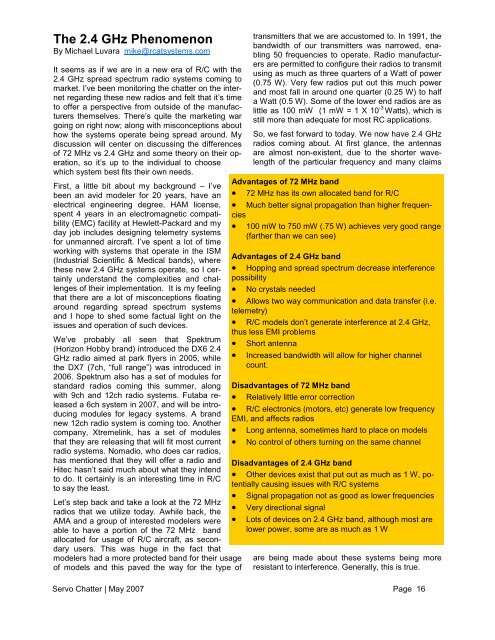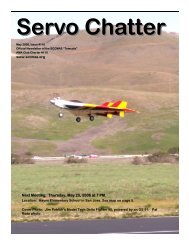Servo Chatter
Servo Chatter - Santa Clara County Model Aircraft Skypark
Servo Chatter - Santa Clara County Model Aircraft Skypark
- No tags were found...
You also want an ePaper? Increase the reach of your titles
YUMPU automatically turns print PDFs into web optimized ePapers that Google loves.
The 2.4 GHz Phenomenon<br />
By Michael Luvara mike@rcatsystems.com<br />
It seems as if we are in a new era of R/C with the<br />
2.4 GHz spread spectrum radio systems coming to<br />
market. I’ve been monitoring the chatter on the internet<br />
regarding these new radios and felt that it’s time<br />
to offer a perspective from outside of the manufacturers<br />
themselves. There’s quite the marketing war<br />
going on right now; along with misconceptions about<br />
how the systems operate being spread around. My<br />
discussion will center on discussing the differences<br />
of 72 MHz vs 2.4 GHz and some theory on their operation,<br />
so it’s up to the individual to choose<br />
which system best fits their own needs.<br />
First, a little bit about my background – I’ve<br />
been an avid modeler for 20 years, have an<br />
electrical engineering degree, HAM license,<br />
spent 4 years in an electromagnetic compatibility<br />
(EMC) facility at Hewlett-Packard and my<br />
day job includes designing telemetry systems<br />
for unmanned aircraft. I’ve spent a lot of time<br />
working with systems that operate in the ISM<br />
(Industrial Scientific & Medical bands), where<br />
these new 2.4 GHz systems operate, so I certainly<br />
understand the complexities and challenges<br />
of their implementation. It is my feeling<br />
that there are a lot of misconceptions floating<br />
around regarding spread spectrum systems<br />
and I hope to shed some factual light on the<br />
issues and operation of such devices.<br />
We’ve probably all seen that Spektrum<br />
(Horizon Hobby brand) introduced the DX6 2.4<br />
GHz radio aimed at park flyers in 2005, while<br />
the DX7 (7ch, ―full range‖) was introduced in<br />
2006. Spektrum also has a set of modules for<br />
standard radios coming this summer, along<br />
with 9ch and 12ch radio systems. Futaba released<br />
a 6ch system in 2007, and will be introducing<br />
modules for legacy systems. A brand<br />
new 12ch radio system is coming too. Another<br />
company, Xtremelink, has a set of modules<br />
that they are releasing that will fit most current<br />
radio systems. Nomadio, who does car radios,<br />
has mentioned that they will offer a radio and<br />
Hitec hasn’t said much about what they intend<br />
to do. It certainly is an interesting time in R/C<br />
to say the least.<br />
Let’s step back and take a look at the 72 MHz<br />
radios that we utilize today. Awhile back, the<br />
AMA and a group of interested modelers were<br />
able to have a portion of the 72 MHz band<br />
allocated for usage of R/C aircraft, as secondary<br />
users. This was huge in the fact that<br />
modelers had a more protected band for their usage<br />
of models and this paved the way for the type of<br />
transmitters that we are accustomed to. In 1991, the<br />
bandwidth of our transmitters was narrowed, enabling<br />
50 frequencies to operate. Radio manufacturers<br />
are permitted to configure their radios to transmit<br />
using as much as three quarters of a Watt of power<br />
(0.75 W). Very few radios put out this much power<br />
and most fall in around one quarter (0.25 W) to half<br />
a Watt (0.5 W). Some of the lower end radios are as<br />
little as 100 mW (1 mW = 1 X 10 -3 Watts), which is<br />
still more than adequate for most RC applications.<br />
So, we fast forward to today. We now have 2.4 GHz<br />
radios coming about. At first glance, the antennas<br />
are almost non-existent, due to the shorter wavelength<br />
of the particular frequency and many claims<br />
Advantages of 72 MHz band<br />
72 MHz has its own allocated band for R/C<br />
<br />
<br />
Much better signal propagation than higher frequencies<br />
<br />
100 mW to 750 mW (.75 W) achieves very good range<br />
(farther than we can see)<br />
Advantages of 2.4 GHz band<br />
Hopping and spread spectrum decrease interference<br />
possibility<br />
No crystals needed<br />
<br />
<br />
Allows two way communication and data transfer (i.e.<br />
telemetry)<br />
R/C models don’t generate interference at 2.4 GHz,<br />
thus less EMI problems<br />
Short antenna<br />
<br />
<br />
Increased bandwidth will allow for higher channel<br />
count.<br />
Disadvantages of 72 MHz band<br />
Relatively little error correction<br />
<br />
<br />
R/C electronics (motors, etc) generate low frequency<br />
EMI, and affects radios<br />
Long antenna, sometimes hard to place on models<br />
<br />
<br />
No control of others turning on the same channel<br />
Disadvantages of 2.4 GHz band<br />
Other devices exist that put out as much as 1 W, potentially<br />
causing issues with R/C systems<br />
Signal propagation not as good as lower frequencies<br />
<br />
<br />
<br />
Very directional signal<br />
Lots of devices on 2.4 GHz band, although most are<br />
lower power, some are as much as 1 W<br />
are being made about these systems being more<br />
resistant to interference. Generally, this is true.<br />
<strong>Servo</strong> <strong>Chatter</strong> | May 2007 Page 16




